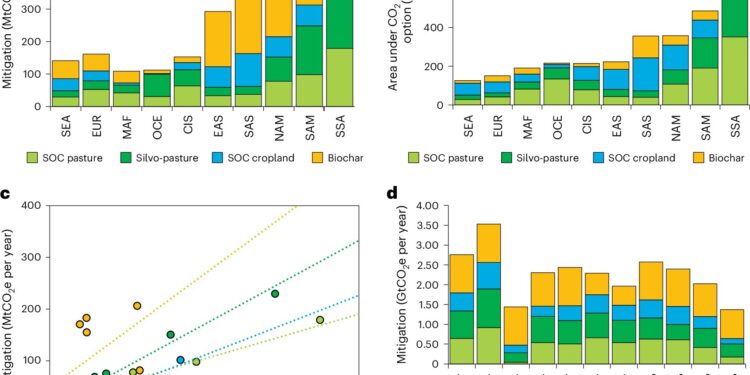Adoption of agricultural CO2 sequestration options in the “agCO”2” scenario with a GHG price of 160 USD2022Total CO22And−1 by 2050. Credit: Natural food (2024). DOI: 10.1038/s43016-024-01039-1
The food system is one of the largest sources of greenhouse gas emissions on the planet. Reducing emissions in this sector is therefore a priority for policymakers around the world. IIASA researchers have explored the potential of carbon sequestration in agricultural lands to combat climate change, providing insights into the economic effects as well as its potential for climate change mitigation.
Carbon sequestration on agricultural land refers to the process of capturing and storing carbon dioxide (CO2 ) from the atmosphere into soil and plants on farms. According to the authors of a new IIASA study just published in Natural foodThese practices have great potential to reduce global warming while reducing economy-wide mitigation costs.
“We set out to assess new options for carbon sequestration on agricultural lands and their dynamics in an economic model. Until now, these options have only been assessed in bottom-up engineering studies and have therefore not been considered in the Integrated Assessment Model-based climate stabilization pathways that underpin the forward-looking chapters of the Intergovernmental Panel on Climate Change (IPCC) reports,” explains lead author Stefan Frank, Senior Researcher in the Biosphere Futures Integrated Research Group of IIASA’s Biodiversity and Natural Resources Program.
“Given the linkages between mitigation options, economic sectors and world regions, integrated economic assessments like ours can provide valuable insights into the system-wide effects of these options.”
To help absorb carbon dioxide from the air and store it in the soil or plants on their farms, farmers can, for example, use techniques like planting cover crops, using biochar (a type of charcoal made from organic waste), or practicing agroforestry (planting trees next to crops or pastures), turning their farmland into a carbon sink.
But why is this so important? The study’s findings indicate that by 2050, these agricultural practices could reduce greenhouse gas emissions as much as planting new forests, particularly in regions like sub-Saharan Africa and South America.
Carbon sequestration on agricultural land is not only important for climate change mitigation efforts, but can also improve agricultural productivity and resilience to climate change, and could help the agriculture, forestry and land use sectors achieve net-zero emissions globally by 2050 at costs of between $80 and $120 per tonne of CO2 equivalent.
“These efforts would not only reduce the overall costs of economy-wide emissions reductions relative to a 1.5°C scenario without agricultural carbon sequestration practices, but also reduce global economic output losses by 0.6% by mid-century under a climate stabilization scenario aimed at limiting warming to 1.5°C,” notes study co-author Andrey Lessa Derci Augustynczik, a research associate in the same program at IIASA.
“Furthermore, farmers could earn substantial revenues from these activities – up to $235 billion by 2050 – if they receive financial incentives for each additional tonne of CO2 stored in soils and biomass at an estimated greenhouse gas price of $160 per tonne of CO2equivalent in 2050.”
The authors stress that implementing these changes will require strong institutions and monitoring systems globally to ensure that farmers adopt these practices correctly and are fairly compensated for their efforts.
“Despite the significant mitigation potential at relatively low cost, agricultural carbon sequestration potentials are mainly located in the Global South, which warrants caution as there are several structural, institutional or social barriers. To unlock these potentials and make significant contributions to ambitious climate stabilization efforts, highly effective institutions and monitoring systems need to be deployed in the short term and the necessary policy incentives need to be put in place quickly,” Frank concludes.
More information:
Frank, S. et al. Enhancing agricultural carbon sinks provides benefits to farmers and the climate, Natural food (2024). DOI: 10.1038/s43016-024-01039-1
Provided by the International Institute for Applied Systems Analysis
Quote: Transforming agriculture from carbon source to sink: Study shows potential of carbon sequestration options (2024, September 23) retrieved September 23, 2024 from
This document is subject to copyright. Apart from any fair dealing for the purpose of private study or research, no part may be reproduced without written permission. The content is provided for informational purposes only.



